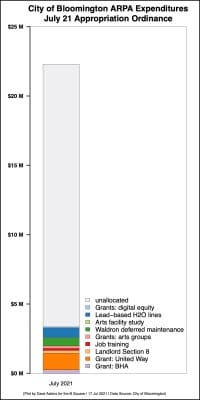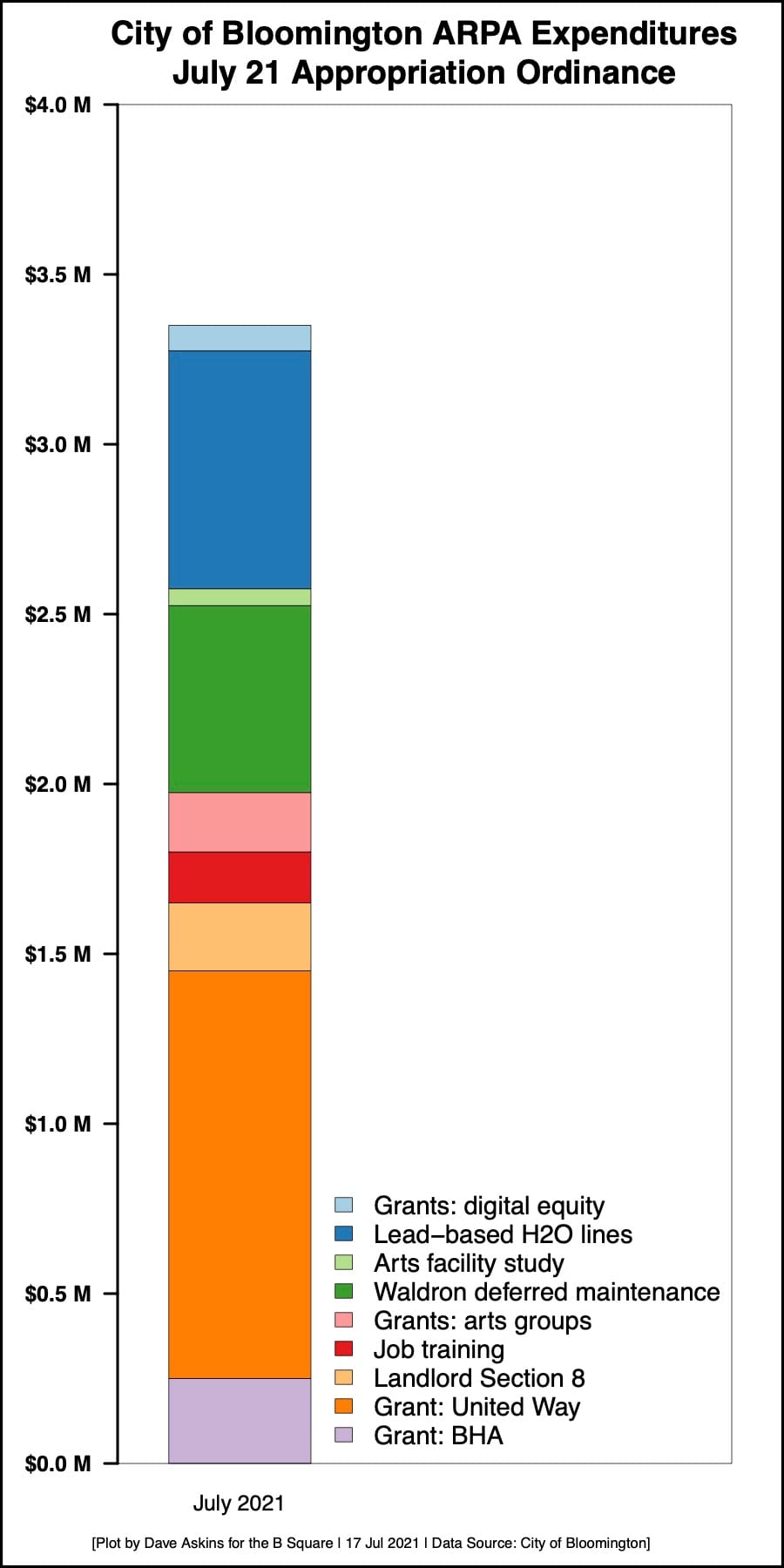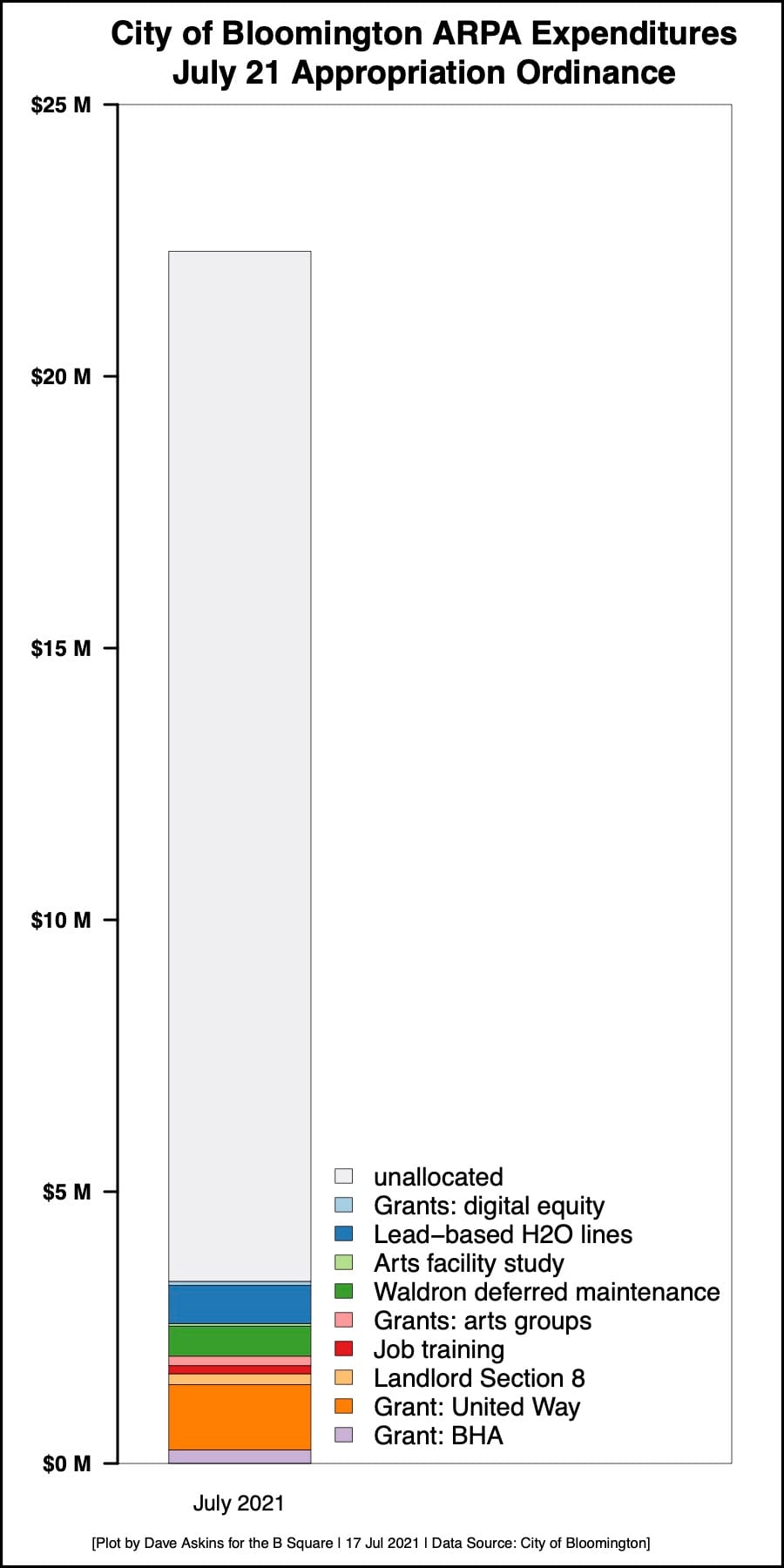American Rescue Plan Act: Bloomington mayor’s initial request to city council: $3.35M for support of housing, the arts, lead pipe removal

When Bloomington mayor John Hamilton announced at a news conference in early June that some of the city’s American Rescue Plan Act (ARPA) funding would be used for housing supports, no dollar amounts were attached.

Now released as a part of the city council’s July 21 meeting information packet is a plan for spending the estimated $22.3 million in ARPA funding that the city is expected to receive through the federal legislation.
An appropriation ordinance that echoes the numbers in the ARPA plan will get a first reading at the meeting.
The ARPA is a $1.9 trillion stimulus bill signed into law by President Joe Biden on March 11, to help counter the effects of the COVID-19 pandemic.
Housing supports, at $1.65 million, are about half of the total in the initial ordinance.
The breakdown for housing is: a $1.2 million grant to the United Way of Monroe County to address homelessness and housing insecurity; a $250,000 grant to the Bloomington Housing Authority to create affordable housing options; and $200,000 to encourage participation by landlords in the federal Section 8 voucher program.
On Friday, the United Way released the report and recommendations of a working group that has been convening since last year to address the question of how to make homelessness “rare, brief and non-repeating.” [Heading Home 2021]
The Heading Home 2021 report gives some idea of the way the $1.2 million grant would be spent. The city’s proposed ARPA plan indicates that more would be added to the $1.2 million in the context of “a projected multi-year operational budget of $3 million.”
The second biggest chunk of the initial appropriation money proposed by the Hamilton administration would pay for identifying lead-based service lines in the city’s water system and preparing for replacement. That’s a $700,000 item in the ordinance.
The other significant piece in the ordinance would go to the arts: $550,000 to pay for deferred maintenance at the Waldron; $175,000 in grants to local arts and cultural groups; and $50,000 to study the potential for a new downtown performing arts facility.
Those dollar amounts had been previously announced, during a news conference at the Waldron held in mid-May. A request for qualifications (RFQ) for the use of the building was issued by the city on Thursday.
The administration will be asking councilmembers at their July 21 meeting, to approve the ARPA plan. The plan is at this point not completely fleshed out. At a couple of places the plan indicates “No requests at this time.”
So councilmembers will be asked to amend the plan over the next months and years and to approve additional appropriation ordinances. ARPA funds have to be obligated by 2024 and spent by 2026.
This past week, the Hamilton administration released the results of a survey of residents about use of the ARPA money.
The appropriation ordinance on the agenda for July 21 will just get a first reading, and will likely be referred for consideration at a July 28 committee meeting, before it gets a vote in August.


The appropriation ordinance also includes items from a fund that is different from the ARPA fund. Under the ordinance, a total of $600,000 would be transferred from the Coronavirus Relief Fund to different lines in the general fund. The two big chunks of CRF money would go towards pay for Coronavirus-related computer and equipment purchases ($300,000) and for cleaning and security of the Switchyard Park restrooms ($260,000).
Here’s the item-by-item breakdown of the proposed spending from the ARPA allocation.
Table: ARPA funding proposal in initial appropriation ordinance
| Program | Amount |
| Grant to the Bloomington Housing Authority to create affordable housing options | $250,000 |
| Grant to United Way for addressing homelessness and housing insecurity | $1,200,000 |
| Efforts to increase landlord participation in federal Section 8 | $200,000 |
| Accelerating job training and employment of underemployed categories of workers | $150,000 |
| Grants to local arts and cultural groups to foster recovery | $175,000 |
| Deferred maintenance at the Waldron to reactivate it as a community arts venue | $550,000 |
| Professional services to evaluate the potential for a new downtown performing arts facility | $50,000 |
| Identification and inventory of all lead-based service lines in the CBU system; prepare for replacement | $700,000 |
| Digital Equity grants advancing the goals of the Digital Equity Strategic Plan. | $75,000 |
| Total | $3,350,000 |




Comments ()